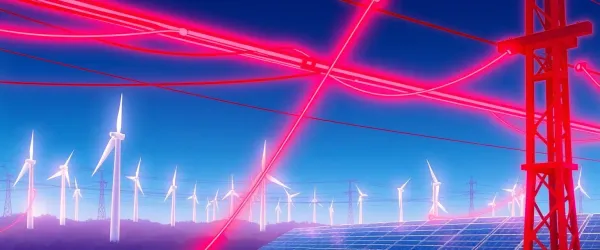
Is it true that Red Eléctrica Española warned about the risks of increasing the share of renewable energies in the energy mix?
Red Eléctrica Española warned about the risks of increasing renewable energies, but with nuance.

Respuesta
Red Eléctrica Española (REE) has indeed issued warnings regarding the risks of increasing the share of renewable energies in the energy mix, particularly in specific contexts related to grid stability and the integration of these intermittent sources. In 2020, internal studies by REE technicians explicitly warned that it was "essential" to increase storage capacity or interconnections to "ensure the operability" of the grid during the green transition . They highlighted that the widespread integration of renewables would have a greater impact on grid stability in Spain than in other European countries due to its limited interconnection capacity . These technicians also suggested "essential" measures to avoid "inadmissible" frequency mismatches, such as the one that occurred on April 28, causing an international blackout . More recently, Redeia, REE's parent company, acknowledged in February a "short-term risk" of "generation disconnections due to the high penetration of renewables" to investors . They warned that this increased grid instability could affect both electricity supply and the company's reputation . Furthermore, Redeia explicitly stated that the continued closure of conventional generation plants (coal, natural gas, and nuclear) due to regulatory decisions "implies a reduction in the firm power and balancing capacities of the electricity system, as well as its strength and inertia," which is crucial for maintaining a steady frequency . Reports from September 2020 and two months prior to a widespread blackout also detailed that REE technicians had laid down "essential" proposals to avoid "unacceptable" imbalances, but these measures were either not implemented or phased in too gradually while green energy production ramped up . The annual report from REE also warned that the closure of conventional plants could lead to a "reduction in the firm capacity and balancing capabilities of the electrical system, as well as its strength and inertia," increasing the "risk of operational incidents" . The National Commission on Markets and Competition (CNMC) also noted in January that tensions in the transmission network had reached or even exceeded maximum allowed voltage values, predicting an increase in the short and medium term . Some observers, including an energy expert from the Spanish National Research Council, have attributed the grid's instability to the "unplanned and haphazard integration of a host of renewable systems" and a lack of responsive stabilization systems .
However, there is also evidence that Red Eléctrica Española has highlighted the successful integration and benefits of renewable energies, and its official statements often frame challenges as hurdles to overcome rather than inherent risks that would prevent the transition. For example, Red Eléctrica proudly declared on April 16 that enough renewable energy had been generated to cover demand, stating, “The ecological transition is moving forward” . Beatriz Corredor, president of Redeia and chair of Red Eléctrica, emphasized that in 2024, renewable generation would reach 149 TWh, the highest historical figure, thanks to increased installed capacity and favorable weather conditions, calling this "a giant step toward the 81% target by 2030" . She also explicitly stated, regarding the April 28 blackout, that it was "wrong to blame the outage on Spain's high share of renewable energy," asserting that "These technologies are already stable and they have systems that allow them to operate as a conventional generation system without any safety issues" . This contradicts the idea that REE is primarily warning against renewables themselves. The secure integration of renewable energies is described as "one of the main challenges for the operation of the electricity system" in the ecological transition, implying a focus on solutions rather than rejection of renewables . The growth in installed capacity has not only increased the renewable share but also reduced CO2 emissions to historic lows . The text also discusses solutions and mitigation strategies that grid operators, including implicitly REE, are exploring or implementing. These include rethinking planning, connection, and operation approaches to benefit from the increasing need for renewables . Specific solutions mentioned are integrated grid planning using AI-driven stochastic optimization, automating connection processes, leveraging generative AI, adapting connection requirements, and standardizing equipment . For operations, technologies like advanced inverters, prime exchangers, virtual synchronous machines, and innovative flexibility services (e.g., inertia procurement, congestion services) are proposed . The importance of cooperation among stakeholders, including transmission operators, regulators, and renewable energy developers, is also highlighted . The text indicates that Spain aims to become a hub for clean energy in Europe, having been a net exporter of energy for three consecutive years . It also notes that many countries, like Denmark and Germany, successfully operate electricity systems with high levels of variable renewable energy by using advanced grid management, energy storage, and strong regional connections, and that high-inertia systems have also suffered failures .
In conclusion, the statement that Red Eléctrica Española warned about the risks of increasing the share of renewable energies in the energy mix is True, but with significant nuance. REE, through its internal studies and statements from its parent company, Redeia, has indeed identified and articulated technical challenges and risks associated with high renewable penetration, such as network inadequacy, network instability, reduced system inertia, and potential generation disconnections . These warnings have been particularly emphasized in the context of recent blackouts and the slow implementation of necessary measures to address these vulnerabilities . However, it is crucial to recognize that REE also actively promotes and supports the integration of renewables, viewing them as a "key pillar" of the energy system and celebrating milestones in renewable generation . Their "warnings" are therefore less about rejecting renewable energy and more about highlighting the complex challenges of integrating intermittent sources and advocating for necessary grid upgrades, increased storage, improved interconnections, and advanced grid management solutions to ensure stability and reliability during the energy transition . The evidence suggests a dual perspective: acknowledging the inherent challenges and risks of high renewable penetration while simultaneously committing to and celebrating the progress of renewable energy integration as a core part of Spain's energy future.
1
1
1
1
1
1
2
2
2
1
2
2
3
4
2
5
4
6
6
6
6
4
7
6
1
2
1
2
3
4
6
1
5
7

